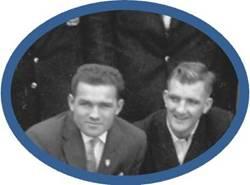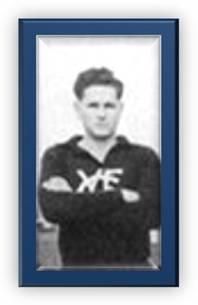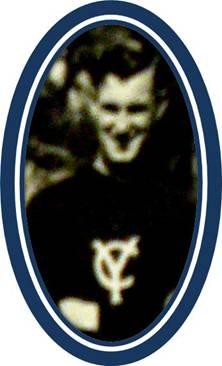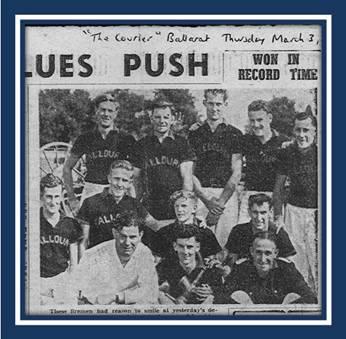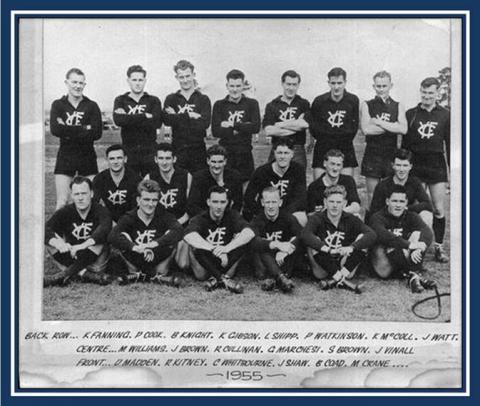The LVFL final four in 1955 comprised Moe, Warragul, Sale and Yallourn. The Blues had taken ‘all before them ’ in the dash to the finals and while surprising the pundits, Yallourn was the ‘wild card in the pack.’ A dazzling victory over the highly fancied Warragul team in the Preliminary Final entitled the Blues to meet Sale in the LVFL Grand Final. The Grand Final was played at Morwell on Saturday, 10 September.
‘The Argus’ headline on the eve of the game read….
“YALLOURN HAS THE SPEED TO BLANKET SALE.”
Further into the body of that story….
“Yallourn started its run six weeks ago and although it scraped into the four ...it has hit top form.”
Sale FC had won the LVFL premiership in1954 and had been the glamour team of the competition for two seasons. With class footballers across all lines and an astute coach in Hugh Murnane (ex-Melbourne1937-40), Sale had taken Gippsland football standards to a new level. Hugh, a renowned tactician and progressive thinker, had built Sale’s game around ‘quick ball movement’ and ‘playing on’ at every opportunity. Much of ‘The Argus’ report by Ron Testro regarding the Grand Final dealt with the fan-fare and parade that preceded the bounce of the ball…
“Twelve hundred war-whooping Sale supporters travelled the 38 miles (63km) to Morwell in a ten-car special train bedecked in the colours and flags with a Sale ‘magpie” on the front of the engine.”
The colourful description of the Sale’s ‘black and white army’ continued…
“Behind the leaders came ten pretty majorettes...then the Sale City Band played ‘Blaze Away’….”
Talk about Joshua’s arrival at the walls of Jericho! Meanwhile the Yallourn players had their own ideas on how to add a bit of life to the day… by using ‘shock tactics’ at the selection table. A study of the line up on that day will explain the Blues’ forward strategy in that Grand Final.
Backs: Stan Brown Keith Gibson Kevin Fanning.
HB: Jim Watt Ken McColl Jim Brown
Centres: Claude Whitbourne Mossie Williams Ray Kitney
HF: Jack Vinall Peter Cook Barry Coad
F: Laurie Shipp Gerald Marchesi Roy Cullinan
Rucks: Bruce Knight Des Madden Jimmy Shaw
19th: Peter Watkinson 20th: Merv Crane
What a forward line! Laurie Shipp, Gerald Marchesi and Roy Cullinan had all played VFL football and formed a most imposing attack. The move of Gerald to full forward had been a stroke of genius in the lead-up to the finals and his ability to find the ‘big sticks’ would have been a worry to Hugh Murnane and the Sale bench that day.
“Captain Gerald Marchesi…has blossomed into a capable forward...and former South Melbourne seconds player Cullinan (Roy) has developed into a handy goal sneak as a permanent forward pocket.” ‘The Argus.’
Furthermore, Peter Cook was a brilliant footballer and there is no doubt that the Sale selectors would have ‘burnt the late night oil’ in working out how to ‘best neutralize’ Peter’s influence across half forward for the Blues.
The game was a titanic struggle from the first bounce. Both defences were in control as all forwards struggled to find space and convert opportunities. In those days, defence was based upon ‘man-on-man’ tactics and ‘zone defence’ (which dominates modern coaching thinking) was unheard of in Australian Rules football.
Yallourn’s defence led by Kevin Fanning was superb early in the game in repelling Sale attacks and keeping the Magpies at bay…
“Failure of Sale’s half forward line and centre line in the second quarter.”
The Blues led by 17 points at half time. The question at the back of everyone’s mind, as the teams headed for the sheds at the big break, was… ‘Could the Yallourn defenders stand tall for another fifty minutes?’
The answer came quickly in the third term.
Hughie Murnane must have fired a rocket during his half time address because Sale hit the ground running. Great teams respond when the outcome is in doubt and Sale ‘took the game on.’ Led by Alan Morrow, the Magpies began to penetrate the Blues’ tight defence and the balance of the contest shifted in a dramatic manner. The game suddenly ‘opened up’ and the ‘lock down’ style of the Blues’ defence snapped and Sale kicked 5.4. (34) to Yallourn’s solitary point for the quarter. In modern day football, Sale’s run on without counter attack is called a ‘surge’ and it takes a lot of stopping. The Blues’ half back line of Jim Watt, Ken McColl and young Jim Brown were under enormous pressure as the Magpie centre line took charge and created opportunities up forward. It is often said that the third term is “the premiership quarter” and the game slipped from Yallourn’s grasp in those vital minutes.
It was a disastrous term for Yallourn and only a ‘full blooded charge’ in the final stanza could reverse the likely outcome.
The Blues reacted with character and true grit. Rovers Barry Coad, and Jimmy Shaw were defiant in the face of defeat and along with ‘Mossie’ Williams gave the Blues supporters some hope. The Blues edged back within two goals but time was their enemy. Sale clung onto take the silverware and the ‘victory train’ back to Sale.
The winner takes all in Grand Finals and the Sale supporters were feverish in triumph.
“…it seemed everyone (from Sale) had won Tatts.”
There had been little between the two great teams, but the result again underlined the significance of the ‘third quarter’ in finals matches. In the wash-up the scoreboard told the truth of the matter.
Quarter by Quarter scores:
Sale : 2.4 3.7 8.11 11.13. (79)
Yallourn: 2.3 6.6 6.7 10.9. (69)
Goals for Sale: Morrow 3 Smith 3 Mc Kee 2 Stanes 2 T.Hart 1
Goals for Yallourn : Cullinan 4 Marchesi 2 Cook 2 Coad 1 Fanning1
Best for Sale: Brewer T.Hart Mason Morrow Finegan Stanley J. Hart Felstenthal
Best for Yallourn: Coad Fanning McColl Williams Marchesi Shaw Knight Gibson Shipp
FOOTNOTES~ PETER COOK, JIM WATT, JIM WATT (JUNIOR) & NOTES ON THE 1955 GRAND FINAL
1. Peter Cook was born on the 1st of November1932 (the same day that the ‘great stayer’ Peter Pan won the Melbourne Cup at Flemington). Peter was the youngest of nine children born to William and Celia Cook. William was a cartage contractor in the Yallourn district. William’s work included hauling newly cut timber sleepers to the numerous railway line construction sites throughout Gippsland. It was hard and back-breaking work in those early days with bullock teams.
2. Peter’s first game of senior football was for Yallourn North FC. Note: The Yallourn North Football Club was formerly known as the Brown Coal Mine and also BCM Imperials). The name change occurred in 1948. (Note: Peter recalls a photograph of himself, as a young lad, wearing the distinctive guernsey of BCM). The NYFC competed in the Mid Gippsland Football League after World War :II
3. Peter clearly remembers his first senior coach was Claude Higginson. Peter believes Claude gave him some very important lessons in the fundamentals of kicking, marking and body work. A photograph of Yallourn North FC in season 1951 shows Peter sitting in the front row of the picture. Other players named in the print include Viv Gore, Jack Taylor, Merv Crane, Bill Skinner, Ron De Carli, Alf Cook, Bill Mackie and Eric Lyons.
4. In 1953, Peter trained at Essendon FC and following an impressive display in a practise match was asked sign what was termed a ‘Form Four’. In those days such forms granted permission for country players to play permit matches in the VFL. Essendon was eager to sign Peter but after some consideration and carefully reading the ‘fine print’, Peter returned home to Gippsland.
5. Peter’s first senior coach in the LVFL was Gerald Marchesi. Peter made an immediate impact for Yallourn FC and began to attract the attention of VFL scouts. He was strong pack mark and long kick. Peter fondly remembers Yallourn’s Kevin Fanning. As a centre half forward Peter appreciated how Kevin’s long drop kicks found Peter on the lead. Kevin was a magnificent kick with the ability to put the ball out in front of the leading player in order that it could be marked ‘without breaking step.’ In that year Peter played with some of Gippsland’s all time greats including Jim Shaw, Bruce Knight, Des Madden, Stan Brown, Laurie Shipp, Mossie Williams and Kevin Fanning.
6. Peter played at centre half forward in the I955 Grand Final at Morwell. The Sale backline included some brilliant country footballers such as George Finegan, Bob Greenwood, Ian Vize, Ian Felsenthal, Syd Smith and Les Wyld but the Yallourn forward line played with great resolve that day. As can be seen from the results above, Roy Cullinan kicked four goals, Gerald Marchesi and Peter Cook kicked two majors for the Blues that day. It was to be Peter’s last appearance in LVFL football.
7. After a transfer dispute that made news in ‘The Argus’, Peter was cleared from Yallourn to Melbourne FC in June 1956. He was given jumper number 21 on the Melbourne list and it was not long before he had forced his way into the Senior XVIII. In such a strong team as Melbourne, Peter’s selection was no minor achievement!
8. Peter made his VFL debut against Fitzroy in Round: 4 at the age of 23 years. The game was played at the Punt Road Oval because of the work that was being undertaken in preparation for 1956 Olympic Games. An estimated crowd of 23000 people watched the game. It was an experience for Peter to play in front of such a large crowd compared to the small but loyal number of supporters who had watched him play for Brown Coal Mine only a few years earlier.
9. Peter’s arrival in Melbourne from Yallourn coincided with the upgrade of the MCG in readiness for the 1956 Olympic Games. The Demons relocated to the Albert Street Oval for training.
10. The company entrusted to undertake the extensive earth moving works to the MCG was Roche Bros. of which Peter was an employee. Peter had also worked for Roche Bros. at the Yallourn Open Cut before leaving for the city. Peter was one of many workers involved in carting (by truck) the thousands of tons of overburden from the Yallourn Open Cut Mine for back filling.
11. It must have been a thrill for a young player from Yallourn to be selected into Melbourne team with such names as Ron Barassi, Laurie Mithen, Stuart Spencer, Ian Ridley, Bob Johnson and John Beckwith. Another player named Jim Sandral made his debut alongside Peter that day. Melbourne’s coach in 1956 was VFL legend Norm Smith. Peter remembers kicking his first VFL goal at the Punt Road Oval that day…
“…it was a grubber that wormed its way over the goal line”.
Melbourne won that game by 19 points.”
12. Peter played 14 senior games for Melbourne between 1956 and 1958 and kicked 6 goals. One of the real highlights of his short career at Melbourne was being part of the Melbourne reserves team that won the 1956 flag in front of a record crowd of 115,802 fans. The scores were:-Melbourne 16.14.110 defeated South Melbourne 10.12.72.
‘The Age’ (17th September 1956) reported…
“…across the half forward line the Demons were given great drive by Brian Collopy and later by Peter Cook at centre half forward”.
Melbourne’s best that day, according to the newspaper, included Crameri, Lord, Kerr, Cook and Jones. The MFC Reserves team was coached by Roy McKay in that season. While playing at MFC Peter also won the Most Consistent Player Trophy in the Reserves grade.
13. Peter played his last VFL game against South Melbourne at the Lakeside Oval in Round: 9 of the 1958 season. Melbourne won convincingly. Readers will be interested to know that Jim Dorgan, who went onto coach Yallourn FC in 1960-61, played for South Melbourne that day.
14. The following summer, Peter travelled to Port Fairy FC to discuss ‘signing on’ but he rejected that offer. His next stop was at Warrnambool FC where Peter found much to his liking. He agreed to play with Warrnambool in the Hampden Football League. History shows that Warrnambool’s recruitment of Peter was somewhat of coup because he turned out be a brilliant performer as a player and also as a club coach.
15. Peter’s record at Warrnambool is most impressive:-
a. He played 100 senior games in the Hampden FL (1959-65).
b. Coached Warrnambool FC for four years 1959-62. Final
c. Premiership Coach in 1959, 60 and 62. (Note: Runners-up in 1961)
d. Non playing coach of WFC premiership team.
e. Captain of Hampden FL in 1965.
f. Coached HFL for four years.
g. Represented the Hampden FL in Victorian Country Championships.
h. Coach of the HFL team that defeated the Ballarat FL in VCFL finals.
i. President of Warrnambool FC in 1968 and 1969.
j. 100 Game Life Member of WFC
k. Peter is listed as a ‘Legend of the 50’s’ on the WFC website.
The history of Warrnambool Football Club book entitled ‘The Birth of the Blues’ carries a glowing tribute to Peter…
“Cook had endeared himself to the supporters because of his competent leadership, outstanding marking and personality. Peter completed an excellent coaching career with a third premiership in 1962”.
Later in the book it highlights that Peter was a key figure in what described as the ‘Golden Era’ of the Warrnambool Football Club.
16. Yallourn North FC / BCM has produced many fine footballers since it was founded in 1920 but it is fair to say that Peter Reville, Gary Crane and Peter Cook are three of the club’s greatest all-time players. Peter Cook only played a couple of seasons with Yallourn FC but he left an indelible mark on the club and has never been forgotten as an eminent forward of that era.
17. At the time of talking to Peter about his football career, he and Nancy were living at Warrnambool. Peter has returned Yallourn in recent years for the Yallourn Old Girls’ Association Reunions where he thoroughly enjoyed catching up with former team mates from Yallourn FC and friends from the township.
JIM WATT
1. After moving with his family into Yallourn from Morwell Bridge in 1941, Jim Watt (born : Sept. 1930) attended YHS and played soccer in his early days in Yallourn. Jim then switched to Australian Rules in 1945.
2. As a teenager Jim remembers playing in the Latrobe Valley Churches Junior FL Grand Final against Traralgon. The team was coached by Yallourn FC legend Kevin O’Neill. According to ‘The Advertiser’ it was a ‘scrappy affair’ early in the game and the strong wind made attractive football virtually impossible. In a gripping and vigourous contest, Traralgon held on to win the flag by 10 points.
Details were: - Traralgon 5.6. (36). defeated Yallourn 4.2. (26).
Goals for Yallourn: - Bill Laurie, Ian Collins, Warwick Squires and Ken Passey.
Best for Yallourn: - Jim Shepherd, Warwick Squires, Tom Oswald and Jim Watt.
3. Jim played his first senior game with Yallourn FC in Round: 4 of 1947. Tom Knight was the YFC coach that season. Unfortunately Jim missed most of the 1948 season because of a serious knee injury (cartilage) and subsequent surgery and rehabilitation. In those days such a medical procedure was a major operation and recuperation in hospital could be up to six weeks of duration. It was common for footballers who had suffered cartilage damage to never play football again. Jim remembers that Dr Andrew successfully operated on his knee and he resumed training in 1949. George Card had returned from Geelong to coach the Blues in that year.
(Note: Dr. James Moore Andrew arrived in Yallourn in 1926…only four years after the formation of the YFC. He was still treating and operating on players more than 40 years later. Dr Andrew was once described as… “the doyen of the local medical fraternity”. Dr Andrew was later to receive an MBE for his services to the people of Yallourn).
Jim suffered further damage to his knee during a Fire Brigade Demonstration at Chelsea in 1953 and was once again laid up for a period of time. On that occasion, one of the great personalities of the Yallourn Medical Centre, Dr Ganz was Jim’s physician.
4. In 1954, Jim was issued with one of the club’s most famous jumpers (number 9) formerly worn by Simon Shaw. Jim was the first player, following the death of the Blues’ champion Simon Shaw in 1953, to wear the coveted guernsey. On the presentation of the guernsey, Jim was told by club officials that it had ‘a very special meaning to the club.’ Jim, who had been a friend of Simon, was ever-conscious of that statement and he wore the jumper with great pride until his enforced retirement from football in1955.
5. Jim played nearly every game for Yallourn as a back man and developed into a key member of a strong defence led by Kevin Fanning and Stan Brown. Jim was often mentioned in the match reviews of that period. In one newspaper report of the Yallourn v Yarragon fixture in August 1954, Jim and Des Madden were praised for their ‘sound’ work in defence. Jim has never forgotten winning match awards to the value of £10.oo that were regularly presented by Father Walsh of St Therese’s Catholic Church.
According to Jim… “Father Walsh was a very good supporter of YFC.”
6. Jim played 3 or 4 reserves matches and 70 (approx) senior games for Yallourn. He won the Most Improved Player award in 1954. In that season, Yallourn’s spirited utility player Bernie Nairn was the club’s Best and Fairest trophy winner . Pat Wheeler (ex- Essendon/Brunswick) was runner-up in the award. Pat was an exciting and skilful midfielder who had played on the wing in the Essendon reserves premiership team of 1950. Pat also represented the LVFL against Gippsland at Maffra in 1954. At the end of the 1954 season Jack Aitken relinquished the coaching job and Gerald Marchesi (ex-North Melbourne) ‘took over the reins’ at Yallourn FC.
7. Jim was a member of the 1955 Grand Final team that played Sale at Morwell. On that day, he lined up on Jim Hart (one of the famous Hart brothers of Sale FC). Jim Watt remembers the dour struggle, the massive crowd and the great support from the Yallourn fans as the Blues fought back bravely in the last term. (See above).
8. The 1955 Grand Final was to be Jim’s last game of football for Yallourn. In December of the same year, Jim tore the cruciate ligament of his right knee so badly in a mishap while fishing at Omeo that he was again hospitalised. Although Dr Ganz (then YFC club doctor) repaired the serious damage, Jim’s knee was ‘shot to pieces’ and he was forced to retire from football. Unless one has played football, it is difficult to imagine the heartache that early retirement, due to injury, can cause young footballers. It was sad way for Jim to ‘hang up his boots’ but Jim was philosophical about his career-ending injury.
9. Jim recollects that…
“The YFC players were always well represented with the Yallourn Fire Brigade. In March 1955 the Yallourn Brigade team won the ‘8 Man Hose & Ladder’ event in record time at the State-wide Annual Demonstrations at Ballarat. It was a premier event and four of the eight firemen were Yallourn footballers.” (Bruce and Daryl Knight (brothers), Bill White and Jim Watt…see photograph posted with this story).
He also mentioned that…
“The competition included teams from major country towns including Ballart, Bendigo, Geelong, Mildura and, in that year, three teams from West Australia. The time set by the Yallourn brigade lasted for about 10 years before it was bettered.”
10. During his football career in the CGFL and the LVFL, Jim played with and against some of the best footballers in Gippsland .He remembers the Shaw brothers, Bruce Knight, Kevin Fanning and ‘Mossie’ Williams as stars of that era. Jim now lives at Inverloch but he has never forgotten the football club, the town and the wonderful people of Yallourn …
“…it was a lovely place to live and work. We were very lucky to be part of it.”
JIM WATT JUNIOR.
Jim Watt’s son, Jim (Junior) also adds to the history of Gippsland football with a remarkable career in umpiring in country football. Jim began umpiring at the age of eighteen and thirty five years later he is still ‘blowing the whistle', in local football. This is ‘young’ Jim Watt’s story…
1. Jim’s son, young Jimmy (born in 1960) played junior football with Newborough and Moe teams in the 1970’s. Jimmy wore his father’s YFC number 9 as captain and full back in the Newborough Bulldogs runner-up Under 12 team in 1972.
2. While playing for Moe in the Latrobe Valley Junior Football League Sunday competition from 1973, he umpired Central Gippsland Junior Football League Under 12 games on a Saturday morning. $5 was the well paid umpiring payment at that time.
3. In 1976, Moe Colts Under 16’s won the premiership and Jimmy was the LVJFL leading goal kicker.
4. In his final year of junior football back at Newborough in the Under 17 Mid Gippsland Football League 1977 competition, despite missing a month with torn ankle ligaments and illness when his teammates won the grand final, he kicked 100 goals for the season including a purple patch of 18, 17 and 11 goals in three straight matches.
5. From 1978 until 2000, young Jim Watt umpired over 550 football matches across Gippsland from Benambra to Wonthaggi for the Latrobe Valley Umpires Association (LVUA)
6. He received life membership of the LVUA in 1987 and served as Assistant Umpiring Director in 1999.
7. His career highlights included senior grand finals in the Latrobe Valley Football League, Mid Gippsland and Gippsland Latrobe Football Leagues, as well as being chosen to field umpire the Latrobe Valley versus Western Border 1993 interleague match played at Leongatha.
8. In 2001, Jim with his 14 year old son, James and 12 year old daughter, Katherine joined the Traralgon Umpires Association (TUA) officiating in junior matches in the Traralgon & District Junior Football League.
9. In 2002, youngest son, Matthew joined the TUA as an 11 year old boundary umpire and five years later as a central umpire reached the 100 game milestone. Youngest daughter, Gemma never umpired football but with Matthew was a competition swimmer for the Traralgon Swimming Club and played netball and basketball. Grandfather Jim was and is still very proud of his grandchildren, and now two great grandchildren – both boys and perhaps potential football umpires.
10. Jim Watt still umpires junior football and has clocked up over 250 games for the TUA to date.
NOTES ON THE 1955 LVFL GRAND FINAL
1. 1955 was Yallourn’s last appearance in a LVFL Grand Final until 1969.
2. The crowd that day was given as 7342 and the gate takings were recorded as £1056 (pounds).
3. The umpire for the Grand Final was W. ‘Bill’ Barbour. Bill umpired 154 VFL games and the VFL 1959 Grand Final between Geelong and Essendon.
4. Gerald Marchesi was re-appointed coach of Yallourn FC in 1956.
5. Roy Cullinan played two senior games with South Melbourne in 1953.
6. George Finegan (Sale’s centre half back in the 1955 LVFL Grand Final) went on to play four VFL games with Geelong FC in 1958.
7. Ian Brewer and his cousin, Alan Morrow went onto successful VFL careers. Ian played 84 games with Collingwood while Alan played 163 games with St Kilda.
8. Hughie Murnane played 52 games with Melbourne (1937-40).
9. Virtual Yallourn has posted stories and further information about Jimmy Shaw, Jack Vinall, Gerald Marchesi, Bruce Knight and Laurie Shipp. A copy of the story of Peter Reville that was written for YYNFC is also available to interested readers.
Written for Virtual Yallourn by Roger Spaull~ May 2013.
For further stories, photographs and memorabilia regarding YFC…click ‘Search’…type ‘Football’ and press ‘Enter.’
Yallourn Fire Brigade Team - 1955
YALLOURN FIRE BRIGADE TEAM in 1955:
Back Row: Ian McArthur, Harold Angove, Bruce Knight, Barry Brewer, Bill White
Middle Row: Lloyd Chudleigh, Barry Coad, Jim Watt
Front Row: Carl Smith, Daryl Knight, Bob Lock
(The Ballarat Courier March 3 1955)
Yallourn Football Club YFC - Grand Final Team 1955
YFC Grand Final Team vs Sale at Morwell in 1955
Back Row: K Fanning, P Cook, B Knight, K Gibson, L Shipp, P Watkinson, K McColl, J Watt
Middle Row: M Williams, J Brown, R Cullinan, G Marchesi, S Brown, J Vinall
Front Row: D Madden, R Kitney, C Whitbourne, J Shaw, B Coad, M Crane
Thank you Roger Spaull and
Thank you Roger Spaull and all those who contribute to this wonderful "Virtual Yallourn" site. I started going to Yallourn matches as a 6 yo, with my Father (Dave Handley). I would so look forward to Yallourn games on that famous No1 Oval and would never miss a match. I well remember that great 1955 side and the excitement build up around the grand-final. Even though I was personally very average (at being average) as a footballer (played for thirds in 1966/67), I loved the game and still do. As a resident of Geelong, I am a member and frequent attendee of Cats games at Kardinia Park. (a five-minute walk for me)
I hold very fond memories of growing up in Yallourn and was a rusted-on supporter of the YFC. As an aside, as secretary of the Newborough FC, I played a pivotal role in negotiation efforts in 1973, to amalgamate the Yallourn & Newborough Football Clubs. The executives of both clubs had agreed on terms of amalgamation and all that remained was for joint (Executive) recommendation to be ratified at a Special General Meetings (SGM) of both clubs. Yallourn agreed but sadly, proposal was defeated at Newborough SGM, because some could not accept the name Yallourn/Newborough FC, even though this "not negotiable" position had been accepted by general committee of Newborough from the onset. To this day, I regret not having foreseen and negated this opposition before this well organised opposition scuttled deal. Yallourn FC, subsequently amalgamated with the Yallourn North FC, hence the new George Bates Oval.
As a further aside, as a "filler" in my retirement, I have decided to write a Memoir and have referred to the Virtual Yallourn site many times to help fill in my memory blanks of those early years in Yallourn. This Memoir is arguably a tad pretentious, but I have kept a daily diary since first starting work at the SEC on 20th January 1964. My placement title is "1947" (year I was born) a philosophical memoir”. Whether it ever reaches fruition, is an open question, but it keeps my mind active and I am enjoying the nostalgic journey.
- Log in to post comments

